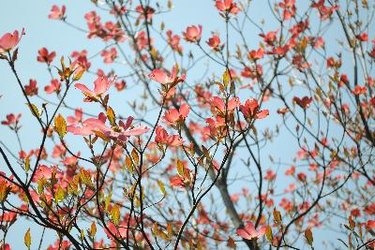
Your choices for a beautiful ornamental tree have come down to the dogwood vs. cherry tree. Which flowering ornamental tree is best for your yard? That depends largely on the available space and growing conditions where you want to plant the tree. These two early spring trees vary in size and have a slightly different look. Their sunlight and care needs are also a little different, which could help you choose between the two.
Identification: Dogwood vs. Cherry Tree
Video of the Day
Ornamental cherry trees (Prunus spp.) are similar to the cherry trees grown for fruit production. However, they're grown more for their showy, delicate white or pink blossoms that open for a short period only in the early to mid spring. Depending on the variety, a cherry tree can have single or double blooms. The timing of the flowers can happen before the leaves develop or at the same time. Ornamental cherry tree leaves typically start out bronze, change to green in summer and end with rich fall color ranging from bronze to yellow-orange.
Video of the Day
Dogwood trees (Cornus spp.) also bloom quite early, sometimes even in the late spring, usually in April and May. Rather than produce actual flowers like many flowering trees, the dogwood instead produces bracts, or leaves that have a petal shape. These bracts can be white, yellow, red or pink. In the fall, the leaves turn red or reddish-purple.
Tree Size Differences
Flowering cherry trees are not very large trees. In fact, they will only reach 15 to 25 feet tall to a similar spread. Height will vary from cultivar to cultivar. Some grow upright while others grow into a weeping shape. They can be used in the landscape for a variety of purposes due to their size and form. Plant them along your property line, driveway or sidewalk as a decorative border. They're also small enough to place near a patio to provide a little shade.
Dogwoods are generally taller than the flowering cherry tree, with the largest cultivars reaching up to 40 feet tall, if grown in the shade. If grown in full sunlight, the dogwood may only reach 15 to 20 feet. They work well as small shade trees, in borders or near a deck or patio. Both trees are relatively slow growers, gaining about a foot a year.
Ideal Growing Conditions
Flowering cherry trees are perennials in U.S. Department of Agriculture plant hardiness zones 5 to 9, depending on species and cultivar. They need full sunlight to thrive with at least 8 hours of direct sunlight daily. Ornamental cherry trees need moist soil that is well drained and well aerated. They require no pruning at all, unless you need to remove dead or diseased limbs.
Dogwoods are also hardy in zones 5 to 9, depending on species and cultivar. They also like moist, well-drained soil, especially soil that is on the acidic side. The dogwood can tolerate full sun, but it prefers partial shade, especially in the afternoon, and the trees often grow faster in the shade. When growing in full shade, dogwoods often don't have as much fall color in the leaves. Dogwood trees need a place that has good air circulation, and they require deep irrigation for dry spells.
Common Tree Problems
Though beautiful, flowering cherry trees can be difficult to maintain since they are susceptible to a whole host of problems. Numerous diseases are common to the cherry tree, including root rot, powdery mildew, canker and blight. Numerous insects such as tent caterpillars and aphids also often infest flowering cherries.
Dogwood trees also have their fair share of problems. The dogwood borer will attack newly planted and weakened trees, while dogwood anthracnose, a relatively new disease, has killed numerous trees across the country. Other potential issues include powdery mildew and root rot.